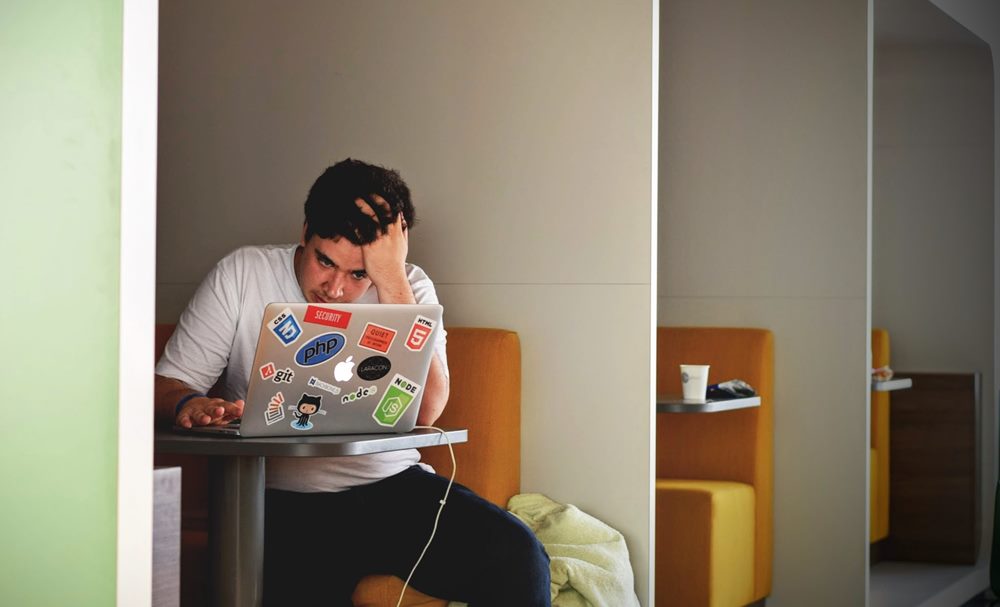Impact of Remote Work on Mental Health and Strategies to Overcome It
As remote work becomes more common, especially in countries like the USA, Canada, and the UK, its impact on mental health is becoming increasingly evident. While remote work offers convenience and flexibility, it also presents unique challenges for mental well-being.
1. A Close Look at Mental Health Challenges

In this section, we’ll explore the mental health challenges that come with remote work. Although remote work offers flexibility, it also introduces some unique issues in this digital era.
Feelings of Isolation
Remote work can make people feel isolated because they miss out on the daily interactions and camaraderie of a traditional office. This lack of face-to-face contact can lead to loneliness and affect overall mental well-being.
Here is how to address it:
- Hold Regular Virtual Meetings: This helps maintain a sense of connection with your team.
- Organize Virtual Social Activities: These can help build and keep team relationships.
- Keep Communication Open: Encourage sharing of experiences and feelings among colleagues.
Blurred Lines Between Work and Personal Life
With remote work, the line between work and home can blur. Without a physical separation, it’s hard to “switch off” from work, which can lead to burnout and stress.
Here is how to address it:
- Set Clear Work Hours: Define when you are working and when you are off.
- Create a Dedicated Workspace: Have a specific area for work to help separate work from home life.
- Follow a Routine: Stick to a schedule similar to a traditional workday.
Rise of Digital Fatigue
Constant use of digital tools can lead to digital fatigue. Many virtual meetings, emails, and notifications can become overwhelming and cause mental exhaustion.
Here is how to address it:
- Take Breaks Between Meetings: Allow time for mental rest.
- Use Asynchronous Communication: For non-urgent issues, use messages instead of meetings.
- Schedule Screen-Free Time: Reduce time spent in front of screens during the day.
2. The Isolation Dilemma: Strategies for Fostering Connections

In this section, we'll delve into the psychological toll that remote isolation can take and emphasize the critical role that social connections play in maintaining mental well-being. It's crucial to recognize the challenges of virtual isolation and, more importantly, explore proven strategies that can effectively foster connections in a remote setting.
- Psychological Toll of Remote Isolation
- Importance of Social Connections
- Proven Strategies for Fostering Connections
Psychological Toll of Remote Isolation
Remote isolation can have a profound impact on an individual's mental well-being. The absence of regular face-to-face interactions can lead to feelings of loneliness, detachment, and a sense of being disconnected from the team or company culture.
Here is why it matters:
- Mental health is closely tied to social connections, and feelings of isolation can contribute to stress and a decline in overall well-being.
- Recognizing the psychological toll helps in understanding the urgency of fostering connections in the remote work landscape.
Importance of Social Connections
Social connections are not just a nicety; they are a fundamental need for human well-being. Strong social ties contribute to a sense of belonging, reduce stress, and create a positive work environment, even in a virtual setting.
Here is why it matters:
- Social connections act as a support system, promoting mental resilience and providing a sense of community.
- Recognizing the importance of these connections helps in building a foundation for effective strategies.
Proven Strategies for Fostering Connections
Virtual Team-Building Activities
Engaging in team-building activities in the virtual space can recreate the sense of camaraderie and teamwork experienced in a physical office. For examples:
- Virtual team-building workshops or exercises.
- Collaborative projects that encourage teamwork.
Scheduled Virtual Coffee Breaks
Replicating the casual interactions that happen during coffee breaks in the office can foster a sense of informality and connection. For examples:
- Scheduled virtual coffee breaks where team members can join for a casual chat.
- Virtual "water cooler" sessions for informal discussions.
- Coffee break-themed team meetings for light-hearted conversations.
Role of Meaningful Interactions
Encouraging meaningful interactions goes beyond surface-level conversations, fostering deeper connections among team members. For examples:
- Structured one-on-one virtual check-ins between team members.
- Team-wide discussions on shared interests or non-work-related topics.
- Recognizing and celebrating personal and professional milestones.
Building a Supportive Work Environment
By examining the isolation dilemma and implementing these proven strategies, organizations can actively contribute to building a supportive work environment in the remote landscape. The aim is not just to address the challenges but to create a virtual space where employees feel connected, supported, and part of a thriving professional community.
3. Balancing Act: Establishing a Healthy Work-Life Equilibrium

Extended work hours, the absence of a physical separation between the office and home, and the constant connectivity can all contribute to an imbalance. It's crucial to not only recognize these challenges but also equip individuals with practical tips to set boundaries, take breaks, and create a dedicated workspace.
- Challenge of Maintaining Balance
- Impact of Extended Work Hours
- Practical Tips for Setting Boundaries
- Empowering Readers with Actionable Insights
Challenge of Maintaining Balance
Remote work often blurs the lines between professional responsibilities and personal life, making it challenging to establish a clear work-life boundary. The convenience of being "always on" can lead to longer work hours and heightened stress levels.
Here is why it matters:
- A lack of work-life balance can result in burnout, decreased job satisfaction, and adverse effects on mental health.
- Recognizing the challenge is the first step towards finding effective solutions.
Impact of Extended Work Hours
The absence of a commute and the flexibility of remote work can inadvertently lead to extended work hours, disrupting the natural rhythm of the workday and encroaching on personal time.
Here is why it matters:
- Extended work hours can contribute to fatigue, decreased productivity, and a diminished sense of personal time.
- Understanding the impact is crucial for individuals to prioritize their well-being.
Practical Tips for Setting Boundaries
Define Clear Work Hours
Establish specific work hours to create a structured routine, helping individuals delineate between work and personal time. For example:
- Set a daily work schedule and communicate it clearly to colleagues to manage expectations.
Create Designated Breaks
Schedule breaks throughout the day to rest and recharge, preventing the continuous and draining work momentum. For example:
- Utilize the Pomodoro Technique, taking short breaks every 25 minutes of focused work.
Establish a Dedicated Workspace
Designate a specific area for work to create a physical boundary, mentally separating work and personal life. For example:
- Choose a quiet corner or room as a dedicated workspace, away from distractions.
Empowering Readers with Actionable Insights
Prioritize Self-Care
Encourage individuals to prioritize self-care activities to maintain mental and physical well-being. For example:
- Schedule regular exercise, breaks for meals, and sufficient sleep to recharge.
Communicate Boundaries Effectively
Effective communication is key in remote work. Encourage individuals to communicate their work hours and availability transparently to colleagues. For example:
- Use calendar apps to indicate when you are unavailable or in focused work sessions.
Regularly Assess and Adjust
Work-life balance is dynamic. Encourage individuals to regularly assess their routines and make adjustments as needed. For example:
- Conduct a weekly review to evaluate workload, identify stressors, and make necessary changes.
Reclaiming Control Over Time
By acknowledging the challenges and implementing these practical tips, individuals can actively reclaim control over their time and establish a healthy work-life equilibrium. The goal is not only to navigate the challenges of remote work but to empower individuals to thrive both professionally and personally in the digital landscape.
4. Digital Resilience: Combating Zoom Fatigue and Digital Exhaustion

In this section, we'll delve into the pervasive issue of "Zoom fatigue" and the broader challenge of digital exhaustion that individuals often encounter in the realm of remote work.
The constant use of digital tools, virtual meetings, and the screen-centric nature of remote collaboration can take a toll on mental well-being. Our focus will be on providing practical strategies to combat digital fatigue, emphasizing effective communication techniques, and highlighting the crucial role of breaks and offline activities in preserving mental energy.
- Phenomenon of "Zoom Fatigue"
- Broader Issue of Digital Exhaustion
- Strategies to Combat Digital Fatigue
- Empowering Readers with Digital Tools
Phenomenon of "Zoom Fatigue"
The prevalence of virtual meetings, especially on platforms like Zoom, has led to a phenomenon known as "Zoom fatigue." The cognitive load associated with constant video conferencing can contribute to mental exhaustion.
Here is why it matters:
- Zoom fatigue can manifest as increased stress, difficulty concentrating, and a sense of burnout.
- Recognizing this phenomenon is vital for implementing effective strategies.
Broader Issue of Digital Exhaustion
Digital exhaustion extends beyond video conferencing, encompassing the overall strain imposed by prolonged screen time, continuous digital communication, and the constant flow of information.
Here is why it matters:
- Digital exhaustion can lead to decreased productivity, eye strain, and heightened stress levels.
- Understanding the broader issue helps individuals address multiple aspects of digital fatigue.
Strategies to Combat Digital Fatigue
- Effective Communication Techniques
- Importance of Scheduled Breaks
- Offline Activities for Mental Energy Preservation
Effective Communication Techniques
Optimize virtual communication to reduce cognitive load and enhance engagement. For examples:
- Encourage concise and focused agendas for virtual meetings.
- Use alternative communication channels for non-urgent matters.
Importance of Scheduled Breaks
Incorporate regular breaks between virtual meetings to allow for mental rest. For examples:
- Schedule 5-10 minute breaks between consecutive video calls.
- Use breaks for physical activities or brief mindfulness exercises.
Offline Activities for Mental Energy Preservation
Advocate for activities that take individuals away from screens and foster mental rejuvenation. For examples:
- Allocate time for reading a physical book or engaging in a hobby.
- Encourage short walks or moments of outdoor relaxation during breaks.
Empowering Readers with Digital Tools
Use of Productivity Apps
Introduce productivity tools to help manage digital tasks efficiently. For examples:
- Implement task management apps for organized workflow.
- Utilize apps that promote the Pomodoro Technique for focused work intervals.
Virtual Focus Techniques
Explore techniques that enhance focus during virtual work sessions. For examples:
- Implement mindfulness or meditation apps for brief sessions between tasks.
- Utilize noise-cancelling headphones for a distraction-free work environment.
Establish "Digital-Free" Time
Advocate for designated periods without digital engagement to promote mental rejuvenation. For examples:
- Set specific hours for email-free and meeting-free periods.
- Encourage individuals to disconnect from digital devices during leisure time.
Preserving Mental Energy in the Digital Landscape
By acknowledging the challenges of digital exhaustion and implementing these strategies, individuals can actively preserve their mental energy in the digital landscape. The aim is not only to combat Zoom fatigue but to empower individuals to navigate the digital realm in a way that sustains their mental well-being.
5. Mindful Strategies: Cultivating Mental Well-being in the Virtual Workspace

In this pivotal section, we explore mindful strategies as powerful tools for cultivating mental resilience amidst the challenges of remote work. As the digital landscape continues to shape our professional lives, integrating mindfulness, stress management techniques, and physical activity becomes essential.
This section aims to guide readers toward a holistic approach to mental health, emphasizing not only individual well-being but also the importance of fostering a supportive work culture.
- Integrating Mindfulness in the Virtual Workspace
- Stress Management Techniques for Remote Work
- Embracing Physical Activity for Mental Well-being
- Holistic Approach to Mental Health
- Encouraging Employers to Prioritize Supportive Work Culture
Integrating Mindfulness in the Virtual Workspace
Mindfulness involves being present in the moment, cultivating wareness, and making conscious choices. In the virtual workspace, where distractions abound, incorporating mindfulness practices can significantly impact mental well-being.
Here is how to implement:
- Encourage brief mindfulness exercises before or after virtual meetings.
- Introduce mindfulness apps or guided sessions for employees to use independently.
- Establish "mindful minutes" during the workday for brief pauses and reflection.
Stress Management Techniques for Remote Work
Remote work can bring unique stressors. Equipping individuals with effective stress management techniques is crucial for maintaining mental resilience in the face of challenges.
Here are the strategies to share:
- Offer stress-relief workshops or webinars featuring relaxation techniques.
- Advocate for regular breaks and stretching exercises during the workday.
- Promote the use of stress management apps that guide users through calming exercises.
Embracing Physical Activity for Mental Well-being
Regular physical activity is a cornerstone of mental well-being. In the virtual workspace, finding ways to incorporate movement is essential for combating sedentary habits.
Here are the ways to encourage:
- Promote virtual fitness classes or challenges for employees.
- Provide resources for desk exercises or quick stretches during breaks.
- Advocate for outdoor breaks and walking meetings to enhance both physical and mental health.
Holistic Approach to Mental Health
Mental well-being goes beyond individual practices. Encouraging a holistic approach involves considering the broader work culture, emphasizing collective support, and fostering an environment that prioritizes mental health.
Here are the actions to take:
- Promote open communication about mental health in team meetings.
- Offer resources for mental health awareness and destigmatization.
- Establish Employee Assistance Programs (EAPs) to provide professional support.
Encouraging Employers to Prioritize Supportive Work Culture
Employers play a crucial role in shaping the work culture. Encouraging them to prioritize mental well-being fosters a supportive environment that benefits every individual within the organization.
Here are the recommendations:
- Advocate for flexible work schedules that accommodate mental health needs.
- Advocate for flexible work schedules that accommodate mental health needs.
- Encourage leadership to lead by example, emphasizing work-life balance and mental well-being.
Cultivating a Mindful and Resilient Virtual Community
By incorporating mindful strategies into the virtual workspace, individuals can enhance their mental well-being, fostering a resilient and supportive community. This section not only provides practical tools for personal resilience but also advocates for a workplace culture that prioritizes the mental health of every team member.
Conclusion

As we conclude this exploration into the power and importance of cultivating mental well-being in the virtual workspace, it becomes evident that remote work, while transformative, requires a nuanced and intentional approach to preserve and enhance our mental health.
The strategies discussed throughout this comprehensive guide aim not only to address the challenges posed by the remote landscape but also to empower individuals and organizations to master the art of remote well-being.
Sharing is stylish! Gift your friends this awesome read!
